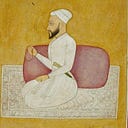I came across a number of samples from Afghanistan, Tajikistan, Iran, and Uzbekistan, so figured I’d plot them out alongside South Asians. Note that samples are collated from Gedmatch Harappa data, a genetic calculator that was designed primarily for South Asians. But it seems to work reasonably well for neighboring ethnicities, so here we are.
- Interesting to see that the South Asian Cline seems to branch once you reach the North-West of the subcontinent. On one end you see many Sindhis continuing in the general direction observed from Sri Lanka all the way into Baluchistan, representing a largely Ancestral Indian + Iranian Hunter Gatherer mixture. Yet Punjabi Khatris (and many upper-caste Punjabis generally) start to break away from this cline, due to their high European and West Asian admixture.
- The distance between the Gujarati and Sindhi clusters may seem surprising to some, as they are neighboring states in the Indian subcontinent. Thanks to a spattering of marshes and deserts between the two however, these regions have had little population flow, and consequently, relatively limited genetic overlap.
- While the average Balochi is quite distinct from the average Sindhi, there is a surprisingly smooth genetic transition between the two populations. This could be explained geographically, as many Baluchi regions are found on lowlands adjacent to Sindhi regions, which would make natural genetic flow easier.
- I’ve touched on this before, but many Pakistani Pashtuns look quite similar to upper-caste Punjabis genetically, and this is observed once again with Khatris overlapping with a large chunk of the Pak-Pashtun cluster. Though I don’t have the samples to prove it, I’m certain that this overlap is seen primarily with Pashtuns found in the lowland areas of KPK province (adjacent to the Indus river). Pashtuns found in the more tribal and highland areas tend to be more similar to Afghan Pashtuns.
- Afghan Pashtuns and Tajiks look fairly similar, exhibiting high West Asian + European admixture, with some individuals being pulled toward the Uzbek cluster due to mixing with Turkic populations over the centuries. Many of the Tajiks found in Tajikistan are distinct from this Afghan cluster however, largely due to higher European admixture (while still exhibiting Turkic admixture).
- Uzbeks and Hazaras are essentially made of the same “stuff” as far as Harappa is concerned. Specifically, a West-Asian base, some European added from the Aryan migrations, plus Eastern-Steppe and East-Asian from the later Turko-Mongol migrations. Hazaras seem to be a bit more East-Asian shifted than Uzbeks, which could be due to having more Mongol admixture than Turkic.
- The Iranian sample includes Balochis, Bandaris, Luris, Mazandaris, and unlabeled “general Iranians”. You do see some close proximity with Pak-Balochis, but not a whole lot, while the Iranians are quite distinct from the Afghan/Tajik clusters. If I had more Khorasani samples from Iran we would likely see some type of convergence with Afghanistan.
That’s all for now!
